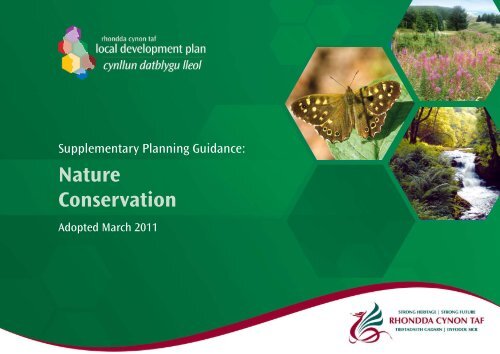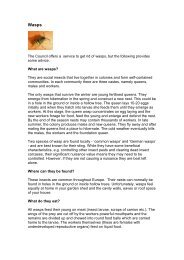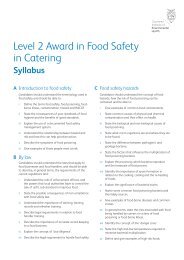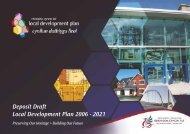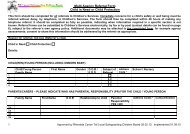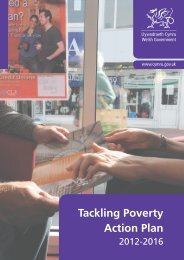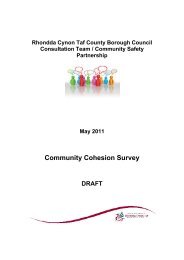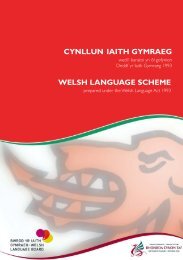LDP nature conservation 2011_Layout 1 - Rhondda Cynon Taf
LDP nature conservation 2011_Layout 1 - Rhondda Cynon Taf
LDP nature conservation 2011_Layout 1 - Rhondda Cynon Taf
- No tags were found...
Create successful ePaper yourself
Turn your PDF publications into a flip-book with our unique Google optimized e-Paper software.
2. Sustainability AppraisalFig.1 Key Social Trends2.5. The Sustainability Appraisal / Strategic Environmental Assessment (SA / SEA)scoping exercise was undertaken between January – April 2006. The process identifiedkey strategic problems, objectives and issues for sustainability. The broad issuesidentified were as follows:• Climate change;• Economic development / housing provision;• Transport;Supplementary Planning Guidance:• Protection of the landscape and biodiversity;Nature• Town centre vitality; and• Cultural change.2.6. A detailed discussion of each of the broad issues identified is contained inConservationthe Sustainability Appraisal / Strategic Environmental Assessment Scoping Report(March 2006).Adopted March <strong>2011</strong>Social, Economic and Environmental Baseline2.7. In order to ensure that a robust basis was established on which to develop aspatial strategy for the <strong>LDP</strong>, a review was undertaken of key social, economicand environmental data. The review of the available data supports the issuesidentified through the pre deposit consultation process and SA / SEA Scopingexercise. The analysis provides a clear picture of the social, economic andenvironmental issues which need to be addressed through the <strong>LDP</strong> process.The key trends identified are as follows:
Nature ConservationContents1. Introduction.....................................................................................................42. Policy Context ..................................................................................................43. Issues ..............................................................................................................54. Planning Objectives and Requirements..........................................................74.1 General considerations.........................................................................74.2 Specific Types of Development Sites .................................................105. Appendices.....................................................................................................135.1 Appendix 1: Regionally Important Geological andGeomorphological Sites (RIGS) ......................................135.2 Appendix 2: Sites of Importance for Nature Conservation (SINC) ....145.3 Appendix 3: Sources of Guidance and Advice...................................175.4 Appendix 4: Description of <strong>Rhondda</strong> <strong>Cynon</strong> <strong>Taf</strong>...............................196. Bibliography...................................................................................................21Local Development Plan 2006 - 2021 • 3
Supplementary Planning Guidance1. Introduction1.1 This Supplementary Planning Guidance (SPG) for Nature Conservation hasbeen produced in conjunction with the <strong>Rhondda</strong> <strong>Cynon</strong> <strong>Taf</strong> LocalDevelopment Plan and provides additional guidance to support the policies,allocations and constraints identified in the Plan. For the purposes of thisSPG, <strong>nature</strong> <strong>conservation</strong> includes biodiversity, soil and earth science features.1.2 <strong>Rhondda</strong> <strong>Cynon</strong> <strong>Taf</strong> is situated in the South Wales Coalfield. The earth scienceheritage reflects the rocks, geological processes, geomorphology and industrialhistory of the County. The geology, climate, soil, landscape, wildlife, land-use,history and culture of the area are closely interconnected. In common withother areas of the Valleys, the extent of semi-natural habitat is unusually high,as is the diversity of habitats. This is one of the key reasons why so much ofthe County Borough is of <strong>nature</strong> <strong>conservation</strong> value. There is a huge varietyof original habitats in a small area, from upland crags and scree to floodplainmeadows. There are important concentrations of nationally significanthabitats and locally distinctive post-industrial biodiversity features. As aconsequence, the County Borough supports a wide range of species.2. Policy Context2.1 The documents listed in the bibliography have informed the LocalDevelopment Plan and this Nature Conservation Supplementary PlanningGuidance. For each reference, a brief description of its relevance to <strong>Rhondda</strong><strong>Cynon</strong> <strong>Taf</strong> or the planning process is outlined.2.2 The <strong>Rhondda</strong> <strong>Cynon</strong> <strong>Taf</strong> Local Development Plan (<strong>LDP</strong>) sets out the policiesthat will be applied in <strong>Rhondda</strong> <strong>Cynon</strong> <strong>Taf</strong>. It also identifies the constraintson development and allocates sites for specific uses.2.3 Relevant Policies in the <strong>LDP</strong>:Policy AW 8 - The Protection and Enhancement of the NaturalEnvironment<strong>Rhondda</strong> <strong>Cynon</strong> <strong>Taf</strong>’s distinctive natural heritage will be preserved and enhanced byprotecting it from inappropriate development. Development proposals will only bepermitted where:-1) They would not cause harm to the features of a Site of Importance for NatureConservation (SINC) or Regionally Important Geological Site (RIGS) or otherlocally designated sites, unless it can be demonstrated that:-a) The proposal is directly necessary for the positive management of thesite; orb) The proposal would not unacceptably impact on the features of the sitefor which it has been designated; orc) The development could not reasonably be located elsewhere and thebenefits of the proposed development clearly outweigh the <strong>nature</strong><strong>conservation</strong> value of the site.4 • Local Development Plan 2006 -2021
Nature Conservation2) There would be no unacceptable impact upon features of importance tolandscape or <strong>nature</strong> <strong>conservation</strong>, including ecological networks, the qualityof natural resources such as air, water and soil, and the natural drainage ofsurface water.All development proposals, including those in built up areas, that may affectprotected and priority species will be required to demonstrate what measures areproposed for the protection and management of the species and the mitigation andcompensation of potential impacts. Development proposals must be accompaniedby appropriate ecological surveys and appraisals, as requested by the Council.Development proposals that contribute to the management or development ofEcological Networks will be supported.Policy NSA 26 – <strong>Cynon</strong> Valley River ParkDevelopment that will contribute to the achievement of the <strong>Cynon</strong> Valley River ParkStrategy will be supported. This includes:1. Proposals for the protection, enhancement, enlargement, connectivity andmanagement of important wildlife sites, species and features of <strong>nature</strong><strong>conservation</strong> value and water quality.2. Proposals to promote public access on foot and by cycle, mitigate and adapt toclimate change, encourage health and well-being and support heritage andtourism.3. Issues3.1 Biodiversity is defined as ‘the variety of life’ and includes plants and animals(species), the places where they live (habitats) and the relationships betweenthem (ecosystems). Planning policy aims to halt biodiversity loss, protectecosystem services and where possible contribute to its enhancement.3.2 Earth Science includes the underlying geology (solid rock and surface deposits)together with the natural geomorphologic processes at work in the landscape.Earth science features have developed over very long timescales and cannotbe replaced. Earth science resources may also be of economic value. Theobjective of the planning policy is to retain the significant feature(s) of theidentified sites.3.3 The soil is the interface between earth science and biodiversity. Soils have amajor biodiversity value, with at least half of all species living below ground.Soils are also significant carbon stores. The main threats to Welsh soils arefrom climate change and the decline in organic matter, from soil sealing (forexample by buildings and roads), from contamination (including acidificationand eutrophication), soil erosion, and degradation of soil structure and soilloss to extraction.2.4 The Constraints Map shows the location of the Special Areas of Conservationand Sites of Special Scientific Interest, with the Proposals Map showing thelocations of the Sites of Importance for Nature Conservation, RegionallyImportant Geological Sites and Local Nature Reserves within the CountyBorough.Local Development Plan 2006 -2021 • 5
Supplementary Planning Guidance3.4 Ecosystem services are those services provided by the natural environmentthat benefit people (Defra 2007). Some, such as food, fibre and fuel provision,recreation and appreciation of <strong>nature</strong>, are well known. Other services suchas climate regulation, purification of air and water, flood protection, soilformation and nutrient cycling receive less recognition but directly andindirectly affect human well-being.3.5 Section 40(1) of Natural Environment and Rural Communities Act 2006 (NERC)places a duty on every public authority, in exercising its functions, to “haveregard, so far as is consistent with the proper exercise of those functions, tothe purpose of conserving biodiversity.” This guidance sets out the mannerin which the Local Planning Authority will comply with this duty.3.6 Protected SitesProtected sites include Special Areas of Conservation, designated by the WelshGovernment, Sites of Special Scientific Interest, designated by the CountrysideCouncil for Wales, and Sites of Importance for Nature Conservation (SINC) andRegionally Important Geological Sites (RIGS) designated as part of the <strong>LDP</strong>.3.6.1 RIGS have been designated on the basis of an Earth Science Audit. For eachsite the primary and secondary features of importance have been identified.The Earth Science Audit and the RIGS descriptions are published separately.Further information is provided in Appendix 1.3.6.2 SINC have been designated on the basis of specific criteria for the Mid Valleysarea of South Wales. For each site the primary and secondary features ofimportance are identified. The Mid Valleys Criteria and the SINC descriptionsare published separately. Further information is provided in Appendix 2.3.6.3 The Local Nature Reserves (LNR) are owned or managed for <strong>nature</strong><strong>conservation</strong> by <strong>Rhondda</strong> <strong>Cynon</strong> <strong>Taf</strong> County Borough Council. Wildlife TrustReserves (WTR) in <strong>Rhondda</strong> <strong>Cynon</strong> <strong>Taf</strong> are owned or leased by the Trust. Allthe LNR and WTR fall within Sites of Importance for Nature Conservation.3.7 Ecological Connectivity and habitat fragmentation are important wildlife<strong>conservation</strong> issues. Small, isolated populations of species are far morevulnerable to extinction than populations that can disperse and interbreedwith other populations. The effects of climate change are likely to increaselocal extinctions among small isolated populations. It is therefore importantto maintain and enhance ecological networks of semi-natural habitats thathave a high degree of connectivity. The Habitat Regulations (37) requireplanning policies which conserve features of the landscape that are of majorimportance for wild flora and fauna, including those linear features that areessential for the migration, dispersal and genetic exchange of wild species.3.8 The management of land has important <strong>nature</strong> <strong>conservation</strong> implications,and in a planning context, this is also recognised by the Habitats Regulations.3.9 Protected SpeciesThe presence (or likely presence) of a protected species is a material planningconsideration and developers must consider this prior to submitting a planningapplication.3.9.1 European protected species are protected under the Conservation (NaturalHabitats, etc.) Regulations 1994 (Referred to in the UK as the HabitatRegulations) Schedules 2 and 4 list the protected species.3.9.2 Bats are unusual compared to other protected species as it is extremelydifficult to predict where they may be roosting and foraging. Guidance onbats and the planning process is currently being produced for use by LocalPlanning Authorities in Wales.6 • Local Development Plan 2006 -2021
Nature Conservation3.9.3 UK protected species are protected under the Wildlife and Countryside Act 1981 asamended by the Countryside and Rights of Way Act 2000 (CROW). Protected speciesare listed under Schedules 1 (Birds), 5 (Animals) and 8 (Plants).3.9.4 Badgers and their setts are protected under the 1992 Protection of Badgers Act.3.9.5 All wild birds (with certain exceptions) are given basic protection from intentionalkilling or injuring, and damage or destruction of a nest whilst it is in use or beingbuilt. Certain birds are given additional protection.3.10 Habitats and SpeciesThe Welsh Assembly Government has published a list of habitats and speciesof principal importance in Wales, as required under Section 42 of theCountryside and Rights of Way Act 2000. The presence of these habitats andspecies is a material consideration and has informed the SINC criteria.3.10.1 Action for Nature: the Local Biodiversity Action Plan (LBAP) for <strong>Rhondda</strong> <strong>Cynon</strong><strong>Taf</strong> sets out a programme of action for a range of partners to conserve andenhance the biodiversity of <strong>Rhondda</strong> <strong>Cynon</strong> <strong>Taf</strong>. The LBAP lists the habitatsand species of particular importance in <strong>Rhondda</strong> <strong>Cynon</strong> <strong>Taf</strong> and these haveinformed the SINC criteria.3.10.2 Trees, woodlands and hedges are among the habitats of importance forwildlife but, additionally, may be protected by Tree Preservation Orders (TPOs),the Hedgerow Regulations and felling license requirements. TPOs and theHedgerow Regulations provide protection for specific trees, woodlands andspecific types of hedgerow and are a material consideration in planningdecisions. Felling licences are required (from the Forestry Commission Wales)for the removal of trees totalling above 2m 3 in volume (for sale) or 5m 3 inother circumstances (per calendar quarter).3.11 River corridors are an important component of the natural environment inthe County Borough. All major rivers qualify as SINC habitat and many supportprotected species. River corridors provide connectivity through urban andrural areas. The Water Framework Directive requires that all rivers achieveand maintain good ecological status. Development proposals likely to affectriver corridor habitat, protected species or water quality should have regardfor these issues.4. Planning Objectives and Requirements4.1 General Considerations4.1.1 As a general principle, the Council will expect the developer to providesufficient information to inform a decision about the <strong>nature</strong> <strong>conservation</strong>value of the site. Because of the extent of semi-natural habitat in the CountyBorough, there are few development sites where <strong>nature</strong> <strong>conservation</strong> is not arelevant issue. Even within the built up area, bats and nesting birds will needto be considered.4.1.2 It is therefore recommended that <strong>nature</strong> <strong>conservation</strong> issues are consideredas early as possible within the scoping and design of development proposalsand that early consultation is undertaken with the Council to ensure thatrelevant information is supplied at the outset and delays avoided.4.1.3 Information supplied to the Local Planning Authority, as part of a planningapplication, will normally be available for the public to view on the applicationfile. Developers will be expected to provide the ecological information,submitted in support of their application, to the South East Wales BiodiversityRecord Centre.Local Development Plan 2006 -2021 • 7
Supplementary Planning Guidance4.1.4 The following are material considerations to be addressed as part of aplanning application;4.1.5 Development should not lead to the net loss of biodiversity, should protectecosystem services and, where possible, contribute to biodiversityenhancement, in accordance with the policy principles in <strong>LDP</strong> policy AW 8.4.1.6 The significant features of European and nationally designated sites, SINCSand RIGS should be protected. Applicants will be expected to show how thefeatures for which the site is designated are to be protected, and wherepossible, enhanced.4.1.7 Where European sites may be affected by development, assessments of likelysignificant effects and, where necessary, appropriate assessment should be made.4.1.8 Development should be carried out in a way that conserves features of thelandscape that are of major importance for wild flora and fauna, includingthose linear features that are essential for the migration, dispersal andgenetic exchange of wild species.4.1.9 Ecological connectivity between habitat patches is generally good in<strong>Rhondda</strong> <strong>Cynon</strong> <strong>Taf</strong> and the impact of development on this connectivitywill be a material consideration. Development that reduces connectivitybetween habitats will not normally be favoured, however there may beopportunities for development to contribute to ecological connectivity.Planning decisions will be informed by research work being undertaken atthe local, regional and Wales level with regard to ecological connectivity.4.1.10 The presence of a protected or priority habitat or species is a materialconsideration and must be addressed by the application.4.1.11 The following paragraphs are relevant to the consideration of applicationswith <strong>nature</strong> <strong>conservation</strong> implications.4.1.12 Pre-application enquiries are welcomed, to identify whether the applicationis likely to affect a designated site or important species and to identify anyopportunities for enhancement. This initial scoping will identify that either:i) there is no requirement for detailed ecological assessment or mitigation,orii) a SEWBREC search for statutory protected species is required and/ oriii) a detailed ecological survey and assessment will be required oriv) there is sufficient ecological information to recommend refusal on <strong>nature</strong><strong>conservation</strong> grounds.4.1.13 The level and detail of the necessary ecological survey and assessment mustbe specific to each planning application and should be undertaken by asuitably qualified ecological consultant at the appropriate time of year. Todetermine the requirements, the Local Planning Authority may consult withstatutory consultees. An iterative approach to survey assessment is generallyadvocated, with baseline assessments advising the requirement for, andextent of, more detailed follow-up survey work where necessary.8 • Local Development Plan 2006 -2021
Nature Conservation4.1.14 In many cases ecological concerns will be restricted to one species or feature. Forexample building demolitions may often only require bat and bird surveys. Inother cases a baseline ecological assessment (using standard Phase I HabitatSurvey methodology) may be sufficient in order to assess habitat features and toidentify the potential for statutory protected species. In other cases a detailedsuite of surveys may be required, which could include habitat assessment toPhase II standards, and/or detailed audits of lower and higher plants,invertebrates, amphibians, reptiles, fish, birds and mammals.4.1.15 Ecological survey reports must also include an appraisal of the significance offeatures and species within the application site, the impacts and implications ofthe proposed development on those features and the extent of mitigation, andenhancement measures, which the application will provide.4.1.16 Where a planning application affects trees, woodlands or hedges on or adjacent tothe development site, applicants will be expected to provide information aboutthese and the impact of their proposals on them, both in respect of their <strong>nature</strong><strong>conservation</strong> and amenity value. Where important features are affected, theCouncil will require a tree report as specified in the British Standards Institutes, BS5837: Trees in relation to construction.4.1.17 This report should be based on a survey by an appropriately qualifiedaboriculturalist, categorise the trees and set out the arboriculturalimplications of the proposed development. For trees etc. that are to beretained, or areas to be planted, an Arboricultural Method Statement and aTree Protection Plan should be provided and Construction Exclusion Zonesidentified on the site layout plan. Any specified works to trees etc. shouldconform to BS 3998: Recommendations for Tree work.4.1.18 Where a European Protected Species is likely to be affected by a planningapplication, the following three tests will be applied:i) there is ‘no satisfactory alternative’,ii) it is ‘not detrimental to the maintenance of the populations of the speciesconcerned at favourable <strong>conservation</strong> status in their natural range’ andiii) it is ‘in the interests of public health and public safety, or for otherimperative reasons of overriding public interest, including those of a socialor economic <strong>nature</strong> and beneficial consequences of primary importancefor the environment’.4.1.19 To apply these tests, suitable survey and assessment information is requiredbefore the application is determined, where an application site is consideredto have potential to support a European Protected Species.4.1.20 Where a European Protected Species is likely to be affected, a licence isnormally required from the Welsh Government under the HabitatsRegulations, and a condition will be added to any grant of planningpermission to produce details of this licence prior to starting works.4.1.21 Following receipt of the survey and assessment this will be subject to internaland statutory consultation to assess whether:i) sufficient <strong>nature</strong> <strong>conservation</strong> assessment has been undertaken andwhether a sufficient resolution of issues has been made. If this is the case,the consultation will identify whether the planning application is either:a. acceptable under adopted planning policy, and can proceed or;b. unacceptable, leading to a policy objection.ii) insufficient <strong>nature</strong> <strong>conservation</strong> assessment has been undertaken andfurther survey and clarification is required. The planning application maybe recommended for refusal due to a lack of information.Local Development Plan 2006 -2021 • 9
Supplementary Planning Guidance4.1.22 Mitigation measures are those measures required to reduce to an acceptable levelthe impacts and implications of development on features, habitats or species ofimportance. Compensation measures are designed to offset any impacts thatcannot be avoided or mitigated. In certain circumstances, proposed mitigationand / or compensation may result in the development being consideredacceptable. The extent of mitigation and compensation required will be specificto the proposal, but could include the retention and long-term management ofhabitats and the provision of species-specific measures. The planning proposalmay also be able to provide enhancement measures to actively benefit <strong>nature</strong><strong>conservation</strong>. This could include positive management of, or providingconnections to, adjacent habitats.4.1.23 Planning conditions and / or planning obligations will be used to ensure that theproposed measures are undertaken. Planning obligations will be used wheremeasures require long-term application (over five years), where monitoring willextend over a prolonged period, or the Council or a third party, takes on themanagement of an area with commuted management sums.4.1.24 Similarly, where development proposals include areas of informal open space,water and landscape features, retained or planted trees, <strong>nature</strong> <strong>conservation</strong> areasor features, planning conditions and or planning obligations will be sought whereappropriate to ensure that the land or feature is appropriately managed.4.2 Specific Types of Developments / Sites4.2.1 In addition to the general considerations outlined above, the followingparagraphs provide guidance on specific types of developments/ sites. Theseare not exhaustive.4.2.2 The design of household extensions can have implications for <strong>nature</strong><strong>conservation</strong>, typically in relation to bats or nesting birds. Where an extensionwill affect a large tree, an existing roof, or involves demolition of a buildingor structure, the applicant should seek advice from the Council prior tosubmitting an application. Opportunities to achieve a net benefit forbiodiversity, for example through the provision of nesting or roosting boxes,will be encouraged.4.2.3 Buildings can be of particular importance as nesting or roosting places forbirds or bats. This is true of rural buildings such as barns and urban buildingssuch as schools, chapels and housing. The conversion of older buildingsshould provide opportunities to build replacement or new features intodevelopments.4.2.4 In respect of larger development sites, the SPG on Design and Placemakingidentifies the need to integrate <strong>nature</strong> <strong>conservation</strong> concerns into the designof new developments from the outset. This will enable areas of high <strong>nature</strong><strong>conservation</strong> value to be avoided and positive contributions to <strong>nature</strong><strong>conservation</strong> to be identified.4.2.5 The holistic consideration of landscaping, sustainable urban drainage, activetravel, informal and formal open space and <strong>nature</strong> <strong>conservation</strong> should be akey element of place making.4.2.6 All larger developments should consider opportunities to achieve net benefitfor biodiversity within their design. These should include, where appropriate,the use of up to date best practice, such as:• The use of technologies, such as green / brown roofs;• The inclusion of planting and landscaping schemes that benefit wildlife;• Siting of development to exclude areas of biodiversity interest;10 • Local Development Plan 2006 -2021
Nature Conservation• Enhancement, creation or restoration of locally distinctive natural habitats;• Enhancement measures for species including the provision of artificialnesting sites / roosting sites / hibernacula;• Sustainable management;• Sustainable urban drainage systems; and• Ecological connectivity.4.2.7 The development of each strategic site should aim to achieve no net loss ofbiodiversity. However, it is recognised that because of the strategic importance ofthese sites this objective cannot always be achieved. Where a loss of biodiversitycannot be avoided, the Council require a comprehensive management, mitigationand compensation package. This will require the integration of <strong>nature</strong> <strong>conservation</strong>considerations from the outset. Sufficient survey and assessment work will needto be undertaken at each stage to establish the extent of the existing <strong>nature</strong><strong>conservation</strong> interest, the areas that should be protected and areas whereenhancement can be achieved.4.2.8 Where schemes are required to reach a minimum of Level 3 of the Code forSustainable Homes/ or BREEAM “Very Good” standard for commercial development,schools, etc, the ecology requirements of these standards should be considered inlight of this SPG. Developers should discuss this element of the proposals with theCouncil’s Ecologist at an early stage.4.2.9 Roads should be designed to minimise negative impact on the naturalenvironment and opportunities for biodiversity enhancement should bepursued where possible. Again, the holistic consideration of landscaping,active travel, informal and formal open space and <strong>nature</strong> <strong>conservation</strong> isencouraged. The route and design should seek to minimise habitatdamage (including the effects of lighting, noise, pollution, drainage andhabitat fragmentation) and mitigate impacts and compensate for residualhabitat loss. Where protected species are likely to be present, specialmeasures will be required (for example newt gully pots, dormousecrossings, dark corridors).4.2.10 Where geological exposures are created by highway works, considerationshould be given to protecting these exposures for geological study and<strong>conservation</strong>. Geo-netting should not be undertaken without priorconsultation with the Countryside Council for Wales.4.2.11 The landscaping of highways provides opportunities for mitigation andenhancement measures. Linear corridors can contribute to ecologicalconnectivity between habitat patches in both urban and rural areas. In general,native grassland should be encouraged and tree or hedge planting withindigenous species of local provenance will be expected. Exotic planting, soilenrichment, imported seed mixes and high maintenance specifications shouldbe restricted to high profile urban locations.4.2.12 Where any development requires the creation or upgrading of a highwayor access, the <strong>nature</strong> <strong>conservation</strong> implications of this should be addressed.Local Development Plan 2006 -2021 • 11
Supplementary Planning Guidance4.2.13 Renewable energy proposals that will cause significant damage to existingcarbon/methane stores, such as ancient woodland or deep peat deposits,should be assessed for their net greenhouse gas emissions. This should beundertaken using national and international guidance and best practicerelating to carbon budgets.4.2.14 The design of wind farms on the upland afforested plateau must addressthe impact on the deep peat soils and hydrology, of the individualturbines, the access and the power line infrastructure. Developers will beexpected to survey, to map the extent of the habitat and features presenton the site and in the surrounding area. The assessment should includethe alternative designs or locations considered; how adverse effects willbe avoided wherever possible; how unavoidable impacts will be reducedand mitigated; and how impacts, that cannot be avoided or mitigated, willbe compensated. Proposals for the long-term management of habitat andmonitoring of impacts will be required. Major wind farms may also havesignificant impacts on bird and bat populations and the developer shouldindicate how these impacts have been avoided, minimised orcompensated for. However, it should be considered that large windfarmprojects will be subject to the requirements of the Environmental ImpactAssessment Regulations. The issues set out in this SPG should therefore notresult in a duplication of the scoping requirements for the environmentalstatement of the Environmental Impact Assessment process.4.2.16 Biomass energy proposals should also be assessed for their net carbon savingscontribution. Energy crops that are dependent on high levels of manufacturedfertiliser input or high transport energy demands are unlikely to lead to reducedcarbon emissions. Displacement of local food production on better qualityagricultural land will not be encouraged, although agricultural waste (e.g. straw)may provide feedstock for small scale biomass developments.4.2.17 The Environmental Impact Assessment Regulations (semi-natural areas anduncultivated land) will apply if semi-natural or uncultivated land is broughtinto production. Biomass proposals should avoid areas of high <strong>nature</strong><strong>conservation</strong> value.4.2.18 Hydroelectric power schemes should be designed to minimise their impacton the river environment and in particular on otters and migratory fish.The Environmental Agency Wales may be consulted by the Council withregard to <strong>nature</strong> <strong>conservation</strong> impacts.4.2.19 Small scale solar, photovoltaic and geothermal energy proposals areunlikely to have major <strong>nature</strong> <strong>conservation</strong> implications. However, wherebats are likely to be present, further advice should be sought.4.2.15 Small scale and domestic wind turbines may also have impacts on birds andbats, which should be considered in the design and location of the turbine.12 • Local Development Plan 2006 -2021
Nature Conservation5. Appendices5.1 Appendix 1: Regionally Important Geological andGeomorphological Sites (RIGS)The Council commissioned an Earth Science Audit of <strong>Rhondda</strong> <strong>Cynon</strong> <strong>Taf</strong> in2003/4 from the National Museums and Galleries of Wales and CardiffUniversity.The Council commissioned an Earth Science Audit of <strong>Rhondda</strong> <strong>Cynon</strong> <strong>Taf</strong> in2003/4 from the National Museums and Galleries of Wales and CardiffUniversity. The work was overseen by an expert panel, from the Council, theCountryside Council for Wales, the Geological Association, the University andthe National Museum and Galleries of Wales. An initial desk study of theliterature and geological maps was followed by a field survey. An accessdatabase was developed linked to a Geographic Information System (GIS) maplayer. A transparent methodology for assessing the geo-<strong>conservation</strong> value ofthe sites was developed, using the earlier MINESCAN methodology. Asrecommended in the report, sites scoring above 100 have been included in thelist of RIGS. The sites with the highest geo-<strong>conservation</strong> scores are alreadystatutorily protected as Sites of Special Scientific Interest. Most of the remainingsites lie within Sites of Importance for Nature Conservation, and frequentlytheir features are a contributory factor affecting or determining the ecologicalvalue of the site. A small number of sites, including the two active quarries,remain outside the SINC boundaries. The <strong>LDP</strong> Proposals Map indicates thelocation (but not the extent) of each RIG site. Each site name, location by gridreference and identification number is shown below. Further information suchas full site descriptions, size, primary and secondary features of importanceand photographs are available on request.Loc.No.List of Regionally Important Geologicaland Geomorphological Sites in<strong>Rhondda</strong> <strong>Cynon</strong> <strong>Taf</strong>(from Earth Science Audit 2003-4, L Cherns, MG Bassett and A Haycock)LocalityNameGridRef** Totalscore59 Graig Fawr SS 9225 9600 33527 Craig-y-Llyn SN 9150 0320 31060 Graig Fach SS 9290 9540 31054 Tarren Saerbren cirque SS 9270 9760 310118 Brofiscin Quarry ST 0700 8130 310138 Mwyndy Mine tips ST 0550 8190 31038 Blaenrhondda road cutting (A4061) SN 9300 0060 2854 Bwa Maen SN 9150 0795 270127 Mynydy Cross, Llantrisant road cutting ST 0520 8200 270377 Cefn Park Mine ST 0480 8220 270378 Rhiwsaeson tips ST 0640 8240 27048 Cwm Lluest SS 9180 9970 240161 Navigation Quarry ST 0870 9400 225304 Tarren Felen Uchaf track cutting SS 9505 9495 22030 Craig y Bwlch SN 9435 0350 22020 Llech Syrchyd waterfall SN 9915 0730 220287 Pen Pych and west Blaenrhondda crags SS 9240 9950 21540 Craig Blaenrhondda SN 9205 0130 205Local Development Plan 2006 -2021 • 13
Supplementary Planning GuidanceLoc.No.LocalityNameGridRef** TotalscoreLoc.No.LocalityNameGridRef** Totalscore52 Craig Selsig and Craig y Ddelw SS 9170 9775 20551 Blaencwm landslide SS 9180 9840 205133 Forest Wood Quarry ST 0150 7970 205159 The Gap quarry ST 0785 9643 20032 Lower Craig Blaenrhondda crags and tip SN 9231 0135 20050 Nant y Gwair stream gulley and Cwar y Offeiriad SS 9115 9872 20093 Tarren y Bwllfa SN 9650 0175 18034 River <strong>Rhondda</strong> Waterfall SN 9228 0150 170546 Coed-y-wiw tips ST 0005 8065 17049 Nant yr Ychen stream gulley and crags SS 9160 9925 160536 South Ty Rhos crags SN 9740 0395 160174 Glyncoch Quarry ST 0790 9190 155124 Hendy/Miskin Quarry ST 0555 8120 155210 Craig yr Eos South Dinas Quarry ST 0028 9136 150163 West Navigation quarry ST 0857 9410 150375 Daren y Celyn Quarry ST 0785 9635 140531 Bwllfa Road tips SN 9700 0300 140407 Mynydd yr Eglwys landslide SS 9760 9550 140348 Gelynog colliery spoil tips, Beddau ST 0568 8534 12092 Craig-yr-ysgol SN 9590 0265 115383 <strong>Taf</strong>fs Well hematite workings ST 1360 8370 1101 Old Dinas quarry, Pen-cae drain SN 9170 0795 105120 Small crags west of Gadir Wen House ST 0660 8062 1053 Lower section of River Sychryd SN 9108 0789 100430 Tarren Maen-du quarry and landslide SS 9375 9760 100158 River <strong>Taf</strong>f terrace deposits ST 0825 9350 100348 Gelynog colliery spoil tips, Beddau ST 0568 8534 12092 Craig-yr-ysgol SN 9590 0265 115383 <strong>Taf</strong>fs Well hematite workings ST 1360 8370 1101 Old Dinas quarry, Pen-cae drain SN 9170 0795 105120 Small crags west of Gadir Wen House ST 0660 8062 1053 Lower section of River Sychryd SN 9108 0789 100430 Tarren Maen-du quarry and landslide SS 9375 9760 100158 River <strong>Taf</strong>f terrace deposits ST 0825 9350 100** Total score refer to the geo-<strong>conservation</strong> assessment5.2 Appendix 2: Sites of Importance forNature Conservation (SINC)SINC are an important resource in <strong>Rhondda</strong> <strong>Cynon</strong> <strong>Taf</strong>, protecting locally andnationally important habitats and species.The Mid Valleys Criteria used for the <strong>Rhondda</strong> <strong>Cynon</strong> <strong>Taf</strong> Local DevelopmentPlan provide objective, scientific, sub-regional criteria for the Mid-Valleys area(<strong>Rhondda</strong> <strong>Cynon</strong> <strong>Taf</strong>, Merthyr, Caerphilly and Blaenau Gwent).14 • Local Development Plan 2006 -2021
Nature ConservationThe geography of the County Borough is reflected in the <strong>nature</strong> of the SINC.In the uplands, where there is less built development and extensive areas ofsemi natural habitat, SINC tend to be larger than in the lowlands.The locations of the SINC are shown on the Proposals Map. Individual SINCplans and the site descriptions are available on request. The site descriptionincludes the primary and secondary features of importance together withinformation about survey and other evidence relating to the site.The sites, shown on the Local Development Plan Proposals Map, are based oncriteria applied within the context of the evidence considered at the time whenthe <strong>LDP</strong> was prepared.If an unconstrained development site meets the criteria for designation as aprotected site, it will be treated as if the site was so designated.If the development proposed does not adversely affect the special features ofthe protected site then the designation would not prevent the development.If the developer claims that the site does not meet the criteria for protection,it will be necessary to show that the site did not meet the criteria at the timeof designation.List of Sites of Importancefor Nature ConservationNo. Name No. Name1 Coed Wernhir 21 Mynydd Bwllffa /Mynydd-y-gyngon2 Werfa Farm 22 Cwm Dare North3 Nant Fforch 23 Cwm Dare South4 Brickyard Mire 24 Dare Valley5 Rhigos Tramway 25 Aberdare South6 Cwm Gwrelych 26 Mynydd Ystradffernol7 Hirwaun Industrial Estate 27 Garn Wen and Panwen Garreg-wen8 Clydach Vale 28 Rhos Gwawr9 Hirwaun Ponds 29 Aberdare Mountain10 Hirwaun Common 30 Nant y Wenallt11 Gelli-ben-uchel 31 Cwm y Felin Newydd12 Hirwaun Ponds (North) 32 Aberdare Canal13 Hirwaun Iron Works 33 Mid <strong>Cynon</strong> Floodplain14 Glyncornel 34 Cwmbach Slopes15 Upper <strong>Cynon</strong> Floodplain 35 Gelli Slopes16 Nant Hir Valley and Reservoir 36 Coed Tir Estyll17 Nant Hir Gwyddel 37 Cefnpennar18 Llwydcoed Slopes 38 St Gwynno Forestry19 Bryn-defaid Heath 39 Mynydd Merthyr20 East Llwydcoed 40 Mynydd Brith-weunydd / Llwynypia hillsideLocal Development Plan 2006 -2021 • 15
Supplementary Planning GuidanceNo. Name No. Name41 Twyn Tyllaudefaid Valley Mire 61 Blaenllechau Woodland42 Pont-y-gwaith Hillside 62 Penrhiw Cradoc Fields43 Mynydd Troed-y-rhiw Slopes 63 Cwm Clydach44 Penrhiw Flushes 64 Mynydd Ty’n-tyle Slopes45 Birch Grove Slopes 65 Old Smokey Slopes46 Y Ffrwd 66 Coed Fforest Isaf-Uchaf47Mynydd Dinas /Mynydd y Cymmer67 Perthcelyn Slopes48 Bronwydd Park 68 Pen-twyn-isaf49 Trebanog Slopes 69 Tyntetown Slopes50 Cilely Farm Rhos Pasture 70 Darren y Celyn51 Cwm Hafod Woodland 71 Coed Pen-y-parc52Coed-yr-Hafod WoodlandComplex72 Heol-y-Mynach Pastures53Llys Nant and GraigTwyn-y-glog Woodlands73 Buarth-y-Capel wetland54Mynydd Blaenrhondda andMynydd Ty-Isaf74 Dan y Cribyn55 Craig Pwllfa 75 Lower Clydach Woodlands56 Abercwmboi Lake 76 Maerdy Colliery57 Lower <strong>Cynon</strong> 77 Craig-yr-Hesg / Lan Wood58 Treherbert Slopes 78 Craig-Evan Leyshon Common59 Mynydd y Ffaldau 79 Mynydd Eglwysilian60 Mountain Ash Slopes 80 Pont Sion Norton Woodland and FfriddNo. Name No. Name81 Pontypridd Golf Course 101 Cefn Hendy Community Woodlands82 Coed-Pen-Maen Common 102 Coed-yr-Hendy83Mynydd Meiros /Upper Ewenny Fach103 Pant Marsh84 Meiros 104 Y Graig85Llantrisant Forestryand Craig Melyn105 Llantrisant Common86 Cynllan Wood 106 Cefn Craig Amos87 Hendre Owen / Trecastell Tip 107 Tonyrefail Mountains88 Coed Trecastell 108 Llanilid Valley89 Gwaun Llanhari Wood 109 Garth-Grabban Slopes90 Ty’n Y Waun 110 Rhiwfelin Fawr91 Coedcae Marsh 111 Nant Muchudd92 River Ely 112 Coedcae-mawr93 Ty-Du 113 Pant-y-ddraenen94Ty-Draw (Pontyclunfloodmeadows)114 Crofft -yr-haidd Marshy Grassland95 Llanharry Quarry 115 Nant Gelliwion / Waun Castellau96 Cowbridge Road Playing Field 116 Darran Park97 Ceulan Farm 117 Tonyrefail East98 Heol Miskin Woodland 118 Cae’r-ysgol Woodland99 Talygarn Woodland and Lake 119 The Glyn100 East Miskin 120 Mynydd y Glyn16 • Local Development Plan 2006 -2021
Nature ConservationNo. Name No. Name121 Penrhiw-fer Road Woodland 141 Coed y Fardre122 Penrhiw-fer Road West 142 <strong>Taf</strong>f and <strong>Rhondda</strong> Rivers123 Ystrad Slopes 143 Llantwit Fardre West124Mynydd Gelli-wion andGellwion Slopes144 Caeau’r-llan Slopes125 Coed Craig-Fach 145 Diswylfa Woodland126 Treforest Slopes 146 Efail Isaf South127 Coed Castellau 147 Afon Clun Valley and Rhiwsaeson Hill128 Pen-y-coedcae Grassland 148Nant Myddlyn / Afon Clun /Tor-y-Coed Woodland129 Coedcae-du 149 Ty Newydd Woods and Grassland130 Rhyd-y-llech 150 Mwyndy Lake131 Cwm Colliery Grasslands 151 Cefn Parc Cemetery132 Cwm Colliery Spoil and Lake 152 A4119 Road Verge133 Maendy Quarry 153Hendy Quarry and Miskin ManorSlopes134 Croesged Grassland 154 Fforest Wood Quarry135 Beddau East 155 Rhydhalog136 Duffryn Dowlais 156 Coed y Gedrys and Garth-fawr137 Llantwit Fardre Marsh 157 Fforest Fawr138 Tonteg Marsh 158Ty-Rhiw Woodlands and PenrhosCutting139 Heol-y-Cawl 159 Craig Yr Allt Slopes140 Brynhill Chapel Grassland 160 Coed Caedyrys / Tir Thomas Jones TipNo. Name No. Name161 The Willowford 173 Fernbank East162 <strong>Taf</strong>f Trail Cycletrack 174Llanharan Marsh / Brynna Woods /Jubilee Marsh163 Fforestnewydd 175Ewenny Fach and associatedwoodlands164 Graig Cottages 176 Llanilid165 Mynydd yr Eglwys 177 Dolau Slopes166 Parc Eirin 178 Cwmparc167 Gilfach Road Wetlands 179 Mynydd Tyle-coch168 Mynydd y Gilfach 180 Nant Pentre Forestry169 Gilfach Goch Slopes 181 Treorchy Slopes170 Nant Ciwc 182 Treorchy Cemetery171 Llanbad-fawr Marsh 183 Ton Pentre Slopes172 Cwm Llanbad5.3 Appendix 3 - Sources of Guidance and AdviceCountryside Council for WalesThe Countryside Council for Wales is the Government's statutory advisor onsustaining natural beauty, wildlife and the opportunity for outdoor enjoymentin Wales and its inshore waters.Headquarters, Maes y Ffynnon, Penrhosgarnedd, Bangor, Gwynedd LL57 2DWTelephone: 0845 1306229, Fax: 01248 355782, Email: enquiries@ccw.gov.ukSouth and East Wales Office, Unit 7, Castelton Court,Fortran Road, St Mellon's, Cardiff CF3 0LTTelephone: 0845 1306229, Fax: 01248 355782, Email: southernteam@ccw.gov.ukLocal Development Plan 2006 -2021 • 17
Supplementary Planning GuidanceEnvironment Agency WalesEnvironment Agency Wales reports to the Welsh Government and is the environmentalregulator with wide responsibilities for managing the environment, acting as achampion for the environment, reducing pollution and enforcing pollution legislation,overseeing the management of waste, water resources and freshwater fisheries,reducing the harm caused by flooding and influencing others to achieve positiveenvironmental outcomes by changing attitudes and behaviour.Head Office, Cambria House, 29 Newport Road, Cardiff CF24 0TPSouth East Area Office, Rivers House, St Mellons Business ParkSt Mellons, Cardiff CF3 0EYTelephone: 08708 506506Email: enquiries@environment-agency.gov.ukwww.environment-agency.wales.gov.ukForestry Commission WalesForestry Commission Wales are responsible for managing the 38% of Welsh woodlandsowned by the Welsh Government. They advise on the development of forestry policyand its implementation. They also encourage sustainable woodland managementwithin the private sector and are responsible for administering grants and regulatorywork, including licensing for felling and replanting.Victoria House, Victoria Terrace, Aberystwyth, Ceredigion SY23 2DQTelephone: 0845 604 0845, www.forestry.gov.uk/walesWelsh Government Department of Rural AffairsWelsh Government Department of Rural Affairs is responsible for theimplementation of The Environmental Impact Assessment (Agriculture) (Wales)Regulations 2007.www.wales.gov.uk/about/departments/depcWildlife Trust for South and West WalesThe Wildlife Trust of South and West Wales is a charitable organisation workingexclusively on all aspects of wildlife <strong>conservation</strong> in South and West Wales. Theyprovide habitat and species management advice directly to those managing landand work with key partners and local people to promote habitat enhancementand restoration.The Nature Centre, BridgendTelephone: 01656 724100The Welsh Wildlife Centre, CilgerranTelephone: 01239 621212, E-mail: info@welshwildlife.org, www.welshwildlife.orgSouth East Wales Biodiversity Records CentreSouth East Wales Biodiversity Records Centre (SEWBREC) is the centre for the collation,management and dissemination of biodiversity data for South East Wales.13 St Andrews Crescent, Cardiff CF10 3DBTelephone: 029 2064 1110, Fax: 029 2038 7354Email: info@sewbrec.org,www.sewbrec.org.uk18 • Local Development Plan 2006 -2021
Nature ConservationPlanning for Biodiversity by David Tyldesley and RTPI (1999)This is a good practice guide that aims to help raise awareness of biodiversity<strong>conservation</strong> in the planning system and to improve understanding, help resolveconflict and create opportunities and provide practical guidance on planninginstruments that may contribute to biodiversity <strong>conservation</strong>.www.rtpi.org.ukBritish Standard InstituteThe British Standard Institute has published PAS 2010:2006 Planning to halt theloss of biodiversity. This has been developed to help the planning system play itspart in halting the decline of biodiversity.www.bsigroup.com/ShopInstitute of Ecology and Environmental Management (IEEM)THE IEEM is a non-profit professional body that represents and supports ecologistsand environmental managers in the UK and abroad. It provides a variety ofservices to develop competency and standards in ecology and environmentalmanagement.IEEM, 43 Southgate Street, Winchester, Hampshire SO23 9EHTelephone: 01962 868626, Fax: 01962 868625Email: enquiries@ieem.net, www.ieem.netThink Wildlife Think Protected SpeciesProvides guidance on the protected species likely to be associated with particulardevelopment types or sites in the Glamorgan or Gwent areas.Developing Naturally by Mike Oxford et al (2000)This is a good practice guide developed for the Association of Local GovernmentEcologists relating to development and the planning system in the UK.5.4 Appendix 4 - Description of <strong>Rhondda</strong> <strong>Cynon</strong> <strong>Taf</strong><strong>Rhondda</strong> <strong>Cynon</strong> <strong>Taf</strong> is situated in the South Wales Coalfield. The geology, landscape,wildlife, land-use, history and culture of the area are closely interconnected.<strong>Rhondda</strong> <strong>Cynon</strong> <strong>Taf</strong> extends from the uplands of the Brecon Beacons to the edge ofthe Vale of Glamorgan. The central feature is the coalfield plateau, which is cut bythe <strong>Rhondda</strong>, <strong>Cynon</strong> and parts of the <strong>Taf</strong>f and Ely river valleys. The coalfield plateauis higher (600m), more remote and exposed in the north, with dramatic cwms andextensive areas of forestry. Further south, hill farming predominates. The <strong>Cynon</strong>and <strong>Rhondda</strong> valleys are generally steep-sided with narrow and mostly built up valleyfloors, and bracken covered, farmed or wooded slopes. South of Pontypridd, the <strong>Taf</strong>fValley is wider but heavily developed. The southern part of the County Borough hasa softer, more lowland landscape of farms, woods, commons, towns and villages.The geology is dominated by the Upper Carboniferous rocks, in particular the SouthWales Pennant Formation with its Coal Measures. Older Palaeozoic rocks are exposedaround the rim of the Coalfield.Local Development Plan 2006 -2021 • 19
Supplementary Planning GuidanceMinor outcrops of younger, Triassic rocks occur in the south of the borough near theM4. The coalfield plateau was shaped by the Tertiary uplift and the deep valleys werecut by the glaciers of the late Devensian glaciation. Boulder clay and other glacial debrisoverlie the rocks, periglacial and more recent landslips are also evident.The iron and coal in the rocks led to the development of the Valleys towns duringthe industrial revolution, with most of the houses being built of local stone. Thenarrow, steep-sided valleys have contained built development, roads and railwaysin narrow ribbons by the river. The thin, acid soil and mild climate have supportedtraditional agriculture, native woodlands and more recently forestry plantations.The biodiversity of the County is bound to this heritage. While much of the centralband of the County lies on acid soils and rocks, limestone outcrops in both the northand south. The combination of a complex topography, geology, and geomorphology,and generally poor and unproductive soils creates great natural variety of landform,landscape and biodiversity. The diverse mixed land uses, post-industrial legacy andwet, mild climate further increase this environmental diversity. A huge variety ofhabitats occur in a small area: from upland crags and scree to floodplain meadows.In common with other areas of the Valleys, the extent of semi-natural habitat isunusually high, as is the diversity of habitats. As a consequence, the County alsosupports a wide range of species, some of these being of importance in a Welshcontext.The biodiversity, landscape and historic value of the South Wales Valleys is somethingwhich has only recently been recognised, and provides new considerations, andopportunities for the land use planning of the <strong>LDP</strong>.The soils of <strong>Rhondda</strong> <strong>Cynon</strong> <strong>Taf</strong> reflect the geology, past and present climate, thegeography and ecosystems, and the land-use history of the County Borough. Ingeneral, the upland plateau comprises ‘loamy acid permeable soils with a wet peatysurface’, on the highest ground there is a significant area of ‘deep acid peat soils’. Inthe border Vale, the more productive agricultural land is mostly on ‘well drainedloamy soils’, with some ‘slowly permeable, seasonally wet, loamy and clayey soils’.These also occur on the valley floors within the coalfield as well as the more typical‘slowly permeable, seasonally wet acid soils with a wet peaty surface’. (From thesimplified National Soil Map of Wales). There are also areas of exposed rock and screeand mineral spoil tips with minimal or very thin soil development.20 • Local Development Plan 2006 -2021
Nature Conservation6. BibliographyAssociation of Local Government Ecologists (2008) Biodiversity tool kit Initial draftof the ‘Validation of Planning Applications’ local requirements template.In preparation, with Defra and Natural England, to assist applicants submitting onlineplanning applications. http://www.alge.org.uk/publications/index.phpBodé, G. (2004) Guidelines for the Selection of Wildlife Sites in South Wales,The South Wales Wildlife Sites Partnership, Dingestow.This document informed the Wales-wide criteria and the Mid Valleys Crireria.BRIG, (2007) Revised priority habitats and species lists for the UKBritish Standard Institute (2006) PAS 2010:2006 Planning to halt the loss ofbiodiversityBritish Standards Institute (2005) BS5837:2005- Guide for Trees in Relation toConstructionBritish Standards Institution (1989) BS3998:1989- British StandardRecommendations for Tree workCaerphilly County Borough Council, Merthyr Tydfil County Borough Council and<strong>Rhondda</strong> <strong>Cynon</strong> <strong>Taf</strong>f County Borough Council (2008) Criteria for the Selection ofSites of Importance for Nature Conservation in the County Boroughs of BlaenauGwent, Caerphilly, Merthyr Tydfil and <strong>Rhondda</strong> <strong>Cynon</strong> <strong>Taf</strong>f (the ‘Mid-Valleys Area’)The Mid Valleys Criteria used for the <strong>Rhondda</strong> <strong>Cynon</strong> <strong>Taf</strong> Local Development Plan followthe structure and format of the South Wales Guidelines (Bode, 2004) and develop theearlier ‘Landscapes Working For Wales’ proposed SINC sites (WDA et al., various).Centre for Ecology and Hydrology Bangor, National Soil Resources Institute, Instituteof Grassland and Environment Research, Geoenvironmental Research Centre (CardiffUniversity), Cynefin Consultants (2002) Critical Appraisal of State and Pressures andControls on the Sustainable Use of Soils in WalesIdentifies the important role of soils for biodiversity and ecosystem services. Considersthe importance of soil carbon and its role in the global carbon cycle. Also addressesthe role of soil in food and fibre production, as a source of materials and mineralsand as a repository of historic artifacts and a palaeo-ecological record. The mainthreats to Welsh soils are identified. The description of soils in RCT in Appendix 4 istaken from the simplified National Soil Map of Wales in Chapter 2.http://www.ceh.ac.uk/sections/bef/Wales_Soil_Scoping_Study.htmlLesley Cherns, Michael G Bassett and Andrew Haycock (2004). <strong>Rhondda</strong> <strong>Cynon</strong> <strong>Taf</strong>fEarth Science AuditThis report describes the Earth Science Audit database and the scoring system for RIGSCountryside Council for Wales, National Museums and Galleries of Wales (1996–2000).MINESCAN Partnership ProjectDEFRA (2007) Conserving biodiversity in a changing climate: guidance on buildingcapacity to adaptUK wide guidance establishing six principles: protecting existing biodiversity, reducingsources of harm, developing ecologically resilient landscapes, establishing ecologicalLocal Development Plan 2006 -2021 • 21
Supplementary Planning Guidancenetworks, making decisions based on analysis and integrating measures intomanagement, planning and practice.Environment Agency (2009) Water for life and livelihoods - A consultation on theDraft River Basin Management Plan for the Severn River Basin DistrictPrepared under the EU Water Framework Directive to achieve good ecological statusof rivers, lakes, reservoirs, aquifers, estuaries and coastal waters by 2026. Includesinformation on the current ecological status of rivers in RCT and proposed actions.English Nature et al (2007) The Monarch Report a synthesis for biodiversity<strong>conservation</strong>Modelling Natural Resource Responses to Climate Change in Britain and Ireland.European Union (2000) Water Framework Directive 2000/86/EEChttp://europa.eu/scadplus/leg/en/s15005.htmEuropean Union (2006) Soil Framework Directive 2006/0086http://ec.europa.eu/environment/soil/three_en.htmEuropean Union (2006) Sustainable Development Strategy and the SixthEnvironment Action Programmehttp://ec.europa.eu/sustainable/docs/renewed_eu_sds_en.pdfEuropean Commission (2006) Halting the Loss of Biodiversity by 2010 andBeyond- Sustaining Ecosystem Services for Human Well–beinghttp://eurlex.europa.eu/LexUriServ/LexUriServ.do?uri=COM:2006:0216:FIN:EN:DOCThis Communication from the Commission highlights two particular threats to EUbiodiversity. “First, that of ill-considered land use and development. Member Stateshave particular responsibility, through improved planning, to reconcile land use anddevelopment needs with the <strong>conservation</strong> of biodiversity and maintenance ofecosystem services. Second, the increasing impact of climate change on biodiversity.This reinforces the imperative for effective action on greenhouse gas emissionsbeyond the Kyoto Protocol targets. We must also support biodiversity adaptation toclimate change, while ensuring that climate change adaptation and mitigationmeasures are not themselves harmful to biodiversity.”Glamorgan Biodiversity Advisory Group/Greater Gwent Biodiversity Action Group(2007) Think Wildlife Think Protected Specieshttp://www.biodiversitywales.org.uk/content/uploads/documents/Guidance%20Legislation/Think%20Wildlife%20final%20v2%20Feb%2007.docHMSO (1992). The Habitats Directive 92/43/EEC on the <strong>conservation</strong> of naturalhabitats and of wild fauna and flora.HMSO (1994). The Conservation (Natural Habitats, etc.) RegulationsEuropean protected species listed in Schedules 2 and 4 can be viewed atwww.opsi.gov.uk/si/si1994/uksi_19942716_en_8.htm#sdiv2, andwww.opsi.gov.uk/si/si1994/uksi_19942716_en_10.htm#sdiv4.HMSO (1981). Wildlife and Countryside Act 1981 (as amended)Schedules 1 (birds), 5 (animals) and 8 (plants) list the species protected under the Wildlifeand Countryside Act 1981, as amended by the Countryside and Rights of Way Act 2000.The up to date list can viewed at www.<strong>nature</strong>net.net/law/wcagen.html#introThere is no ‘official’ site, although the Statutory Instruments can be viewed on the HMSOwebsite (www.opsi.gov.uk).HMSO (2000) Countryside and Rights of Way Act 2000 (CROW) (as amended)HMSO (2006) Natural Environment and Rural Communities Act 2006Section 42 of the NERC Act (2006) (formerly Section 74 of CROW) requires the WelshGovernment to published a list of habitats and species of principal importance inWales. Section. 40 establishes the biodiversity duty for public bodies.22 • Local Development Plan 2006 -2021
Nature ConservationHMSO (1949) National Parks and Access to the Countryside Act 1949HMSO (1990) Town and Country Planning Act 1990Provides for the statutory protection of trees of amenity value.HMSO (1992), Protection of Badgers Act 1992, HMSO, LondonProvides protection for badgers and their setts.HMSO (1997), Hedgerow Regulations. Statutory Instrument 1997 no.1160HMSO (1967) Forestry Act 1967 (as amended)Requires a felling licence for certain works to trees:http://www.forestry.gov.uk/pdf/treefellingaugust.pdf/$FILE/treefellingaugust.pdfLiz Howe (May 2007) Advisory Targets for Habitat Creation in <strong>Rhondda</strong> <strong>Cynon</strong> <strong>Taf</strong>Consultation DraftThe Countryside Council for Wales has set minimum targets for habitat creation acrossWales, for the Wales Biodiversity Partnership.Institute for Ecology and Environmental Management Guidelines for surveymethodologyhttp://www.ieem.net/guidelinesforsurveymethodology.aspJoint Nature Conservation Committee (2003) Handbook for Phase 1 Habitat Surveyhttp://www.ccw.gov.ukDL Jones and G Jones (2008) A strategic <strong>conservation</strong> assessment of heathland andassociated habitats on the coal spoils of South Wales. Phase II Assessment ofenvironmental parameters. Countryside Council for Wales CCW Science Report no 824.P.S. Jones, D.P Stevens, T.H. Blackstock, C.R. Burrows & E. A. Howe (eds) (2003). PriorityHabitats of Wales – a technical guide Countryside Council for Wales.J Latham, TH Blackstock and EA Howe (2007) Ecological Connectivity in Wales:planning action to help terrestrial biodiversity respond to habitat fragmentationand climate change Countryside Council for Wales (staff science report no 08/7/1)The Wales maps in this report highlight the importance of the Coalfield Valleys for theextent of semi-natural habitat and the diversity of semi-natural habitat/ Shannon Index.Monmouthshire CC UDP Inspectors reportSites which meet the criteria for designation as a protected site, it will be treated asif the site was so designated.Mike Oxford et al (2000) Developing Naturally Association of Local GovernmentEcologists<strong>Rhondda</strong> <strong>Cynon</strong> <strong>Taf</strong> County Borough Council (2008) Action for Nature: the LocalBiodiversity Action Plan for <strong>Rhondda</strong> <strong>Cynon</strong> <strong>Taf</strong> Part OneAdopted by the Council July 2009Action for Nature; the Local Biodiversity Action Plan (LBAP) for <strong>Rhondda</strong> <strong>Cynon</strong> <strong>Taf</strong>sets out a programme of action for a range of partners to conserve and enhance thebiodiversity of <strong>Rhondda</strong> <strong>Cynon</strong> <strong>Taf</strong>. The LBAP lists the habitats and species ofparticular importance in <strong>Rhondda</strong> <strong>Cynon</strong> <strong>Taf</strong>. It was adopted as supplementaryplanning guidance to the Structure and Local Plans for the <strong>Rhondda</strong> <strong>Cynon</strong> <strong>Taf</strong> area,in October 2000. This was renewed in 2009, pending the adoption of the LocalDevelopment Plan. Part Two provides the detailed habitat and species action plans.Local Development Plan 2006 -2021 • 23
Supplementary Planning Guidance<strong>Rhondda</strong> <strong>Cynon</strong> <strong>Taf</strong> County Borough Council, (2008) Deposit Draft LocalDevelopment Plan 2006 – 2021<strong>Rhondda</strong> <strong>Cynon</strong> <strong>Taf</strong> County Borough Counci Draft <strong>Cynon</strong> Valley River Park Strategyl(2007)<strong>Rhondda</strong> <strong>Cynon</strong> <strong>Taf</strong> County Borough Counci Natural Environment Topic Paperl(2008)<strong>Rhondda</strong> <strong>Cynon</strong> <strong>Taf</strong> CBC, Welsh Development Agency, Chris Blanford Associates (1997)Landscapes Working for Wales: Draft Landscape Strategy for <strong>Rhondda</strong> <strong>Cynon</strong> <strong>Taf</strong>This document combines earlier studies undertaken by consultants for the WDA andthe local authorities for <strong>Rhondda</strong>, <strong>Cynon</strong> and <strong>Taf</strong>f Ely, prior to local government reorganisationin 1996. Volume 4, appendix D4 Ecological Appraisal and Annex 2(confidential) lists proposed SINCs sites used to inform the Local Plans prepared inthe 1990s and subsequently adopted by RCT.RTPI Environmental Planning & Protection Network E-Bulletin,18.04.08The development of an on-line biodiversity planning tool in association with thePlanning Portal.David Tyldesley (1999) Planning for Biodiversity Royal Town Planning Institute.United Nations (1993) Convention on Biological DiversityInternational Treaty to halt biodiversity loss by 2010. http://www.cbd.int/2010-target/UK Climate Impacts Programme (2009) A changing climate for business- businessplanning for the impacts of climate changeThese guidelines were endorsed by the Minister for Planning, Sustainability andHousing in February 2008.National Assembly for Wales Circular 23/2001- New Guidance for Local PlanningAuthorities on European Protected Species and Changes in Licensing ProceduresWelsh Assembly Government The Welsh Soils Action Plan (consultation document)(2008)The draft Plan describes how the planning system should consider the soil resourcein Wales and contains a number of actions with regard to planning and ecosystemservices. These include scrutiny of <strong>LDP</strong>s, the retention of Agricultural LandClassification, capturing data on soil loss to development, quantifying area andimpact upon loss of function, a revision to the British Standard for Topsoil (BS3882)and revisions to relevant Technical Advice Notes (TANs). Research and targetedmanagement to protect carbon rich soils, enhance flood risk management and trackpollution are also proposed.Welsh Assembly Government letter dated 18th February 2008 to Chief PlanningOfficers re Conservation (Natural Habitats &c) Regulations 1994 ref CL-01-08Welsh Assembly Government, Planning Policy Wales (2002)Welsh Assembly Government) People, Places, Futures - The Wales Spatial Plan 2008Update (2008Welsh Assembly Government Special Planning Unit (Jan 2008) South East Wales:Developing the Networked Environmental Region, draft consultants briefWales Biodiversity Partnership (February 2008) Wildlife Sites Guidance Wales: Aguide to developing local wildlife sites in Wales,24 • Local Development Plan 2006 -2021
Nature ConservationWelsh Assembly Government (2008) Design (consultation draft)Welsh Assembly Government (2008) Climate Change (consultation draft)Welsh Office (1996), Nature Conservation and Planning: Technical Advice Note(Wales) 5Welsh Assembly Government The Environmental Impact Assessment (Agriculture)(Wales) Regulations 2007The Welsh Government Department of Rural Affairs is responsible for the implementationof these regulations which cover the conversion of uncultivated land or semi-naturalareas to intensive use and the large-scale restructuring of rural land holdings.http://www.opsi.gov.uk/legislation/wales/wsi2007/wsi_20072933_en_1Welsh Assembly Government, Technical Advice Note (TAN) 5: Nature Conservationand Planning.Welsh Assembly Government Climate change strategy - High level policy statementconsultation (2009)Welsh Assembly Government Climate change action plan consultation (2009)Welsh Assembly Government, Technical Advice Note (TAN) 12: Design (2009)Welsh Assembly Government (2007) Natural Environment and RuralCommunities Act S.42 List of Species and Habitats of Principal Importance forConservation of Biological Diversity in WalesS42 species list:S42 habitats list:Welsh Assembly Government, Local Development Plans Wales:Policy on preparation of <strong>LDP</strong>s (2005)Welsh Assembly Government, Local Development Plans Manual (2006)Wales Biodiversity Partnership, Wales Biodiversity Framework: Making theconnections for biodiversity action in Wales September (2008)Annex H advises that “The aim of a Biodiversity SPG is to raise the profile ofbiodiversity issues in planning, provide more detailed guidance to planners anddevelopers to ensure that biodiversity is taken into account in all developmentproposals and to strengthen links between the LBAP and the Local DevelopmentPlan.”Welsh Assembly Government, (2009) Bioenergy Action Plan for Wales (and ProgressReport (2010).Local Development Plan 2006 -2021 • 25
<strong>Rhondda</strong> <strong>Cynon</strong> <strong>Taf</strong> County Borough CouncilRegeneration and Planning DivisionSpatial Development TeamSardis HouseSardis RoadPontypriddCF37 1DU01443 494735<strong>LDP</strong>@rctcbc.gov.ukwww.rctcbc.gov.uk


